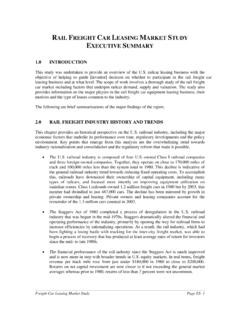Transcription of Negotiation 101 - Logistics
1 Logistics Network, Inc. Box 382 Dumont, NJ 07628-0382 Phone: (201) 387-9420 Fax: (201) 586-0407 Negotiation 101 By Michael B. Stroh Okay, so you re the lucky person responsible for negotiating your com-pany s freight contracts. This is your big opportunity to reduce your company s costs and look like a hero.
2 Now what do you do? Here are some general guide-lines to follow, regardless of the mode of transport. Collect data, data and more data. The more information you can provide to your prospective partners, the better. Carriers need to know as much as they can about your company, the products you are shipping, the destinations you ship to, any special handling characteristics required, and the service expectations you have. At minimum, you should provide the following: Class rating of your products (truck or rail) freight tonnage and transportation spend for this particular category of transportation service Frequency of shipment How quickly does your company pay its freight bills Expected pick-up time and available pick-up time window freight volume by shipping lane Percentage of prepaid vs.
3 Collect freight How do you present this information to your potential supplier(s)? Well it de-pends upon how formal you feel you need to be. If you are dealing with a small group of players (1-3) and you have limited resources at your disposal, then you may want to communicate this verbally or on a simple profile sheet. If you have the resources or you are dealing with a larger group of participants, then a Re-quest for Quote (RFQ) may be in order.
4 A RFQ is a formal document, presented to a group of carriers, requesting them to bid on your freight . It can range in length from a few pages to as many as 15 or 20 depending upon the complexity of your business or the freight volumes being offered. The beauty of this approach is that you know all the participants are singing off the same song sheet, so to speak. In the document, you spell out all the previously specified information about your company, its products, your vol-umes and your expectations.
5 You also specify a bid completion date, by which the carriers must return the completed bid to you. Upon receipt of the completed bid, you analyze the offerings and make your decision. This is an involved process and can take months to properly complete. Do not undertake an initiative like this lightly. If you are negotiating a less-than-truckload (LTL) agreement, there are cer-tain strategies you can take to reduce your costs and simplify the bidding process. Some of the more common are: If you have products with multiple class ratings, try to negotiate a single freight -all-kinds (FAK) rating for all of your products.
6 This simplifies the au-diting process and can reduce your costs by obtaining a lower class rating for at least some of your products. Have all of your carriers use the same rate base. Each carrier publishes their own set of rates, which are not the same. If you can, negotiate a rate base that is older than current rates. Carriers typically take a 5%-6% increase every year. If you use a common rate base with a FAK classification, then price analysis is reduced to comparing discount levels.
7 The key principle of carrier rate Negotiation is: volume is king, but profitabil-ity is queen. If you are a shipper with enormous volumes, you can negotiate from a position of strength. However, depending upon the freight characteristics, this volume appeal could be diminished. If you ship heavy, dense, easy to handle, un-breakable freight then your carriers will love you. However, if your product is lightweight, bulky, susceptible to theft and damage and requires retail delivery, then even vast amounts of freight become less attractive.
8 Moving this type of freight is more costly for the carrier and consequently, makes it less profitable. Bear this in mind during your Negotiation process. One final word: the only thing you can t negotiate is that which you don t mention. Copyright 2002 Michael B. Stroh Mike is the president of The Logistics Network, Inc., a Logistics consulting firm. He is the author of A Practical Guide to Transportation and Logistics , has taught international trade at the World Trade Institute of Pace University, and devel-oped and operates the Logistics web site He can be reached at.






